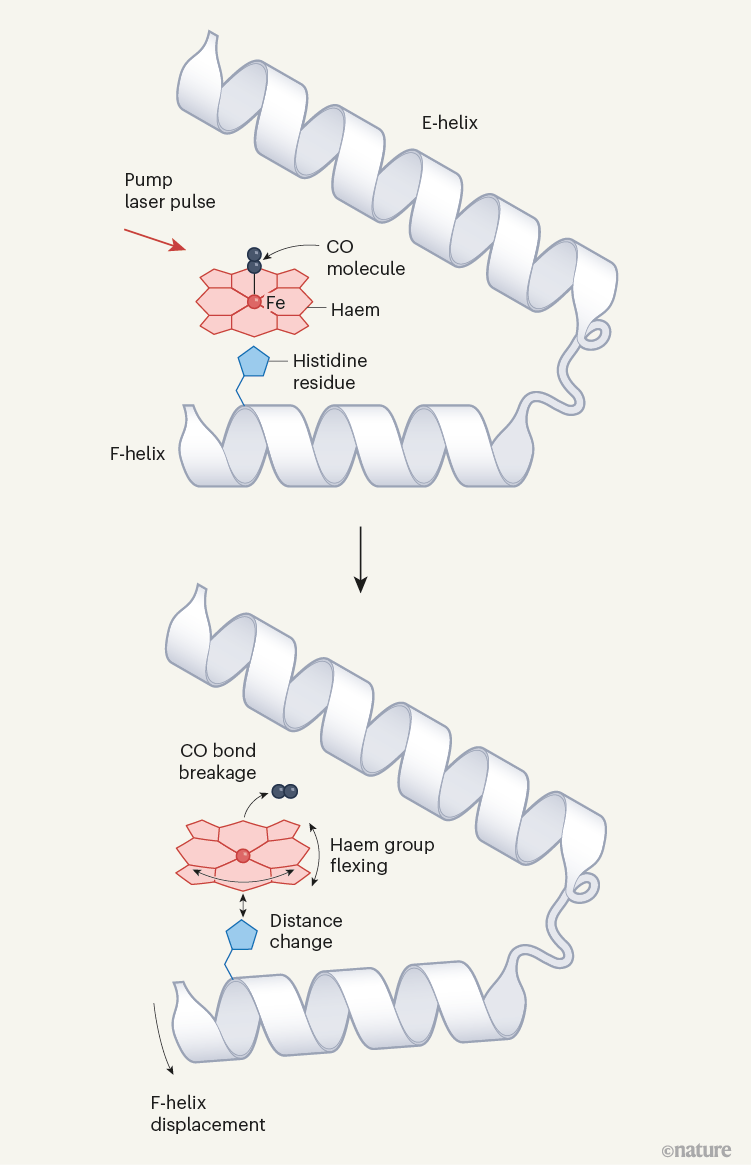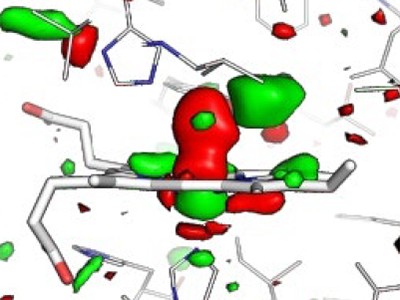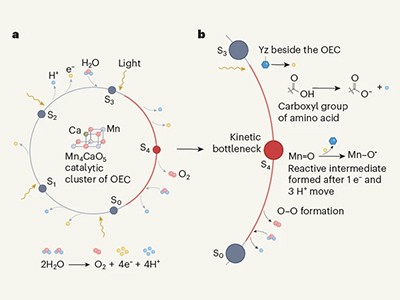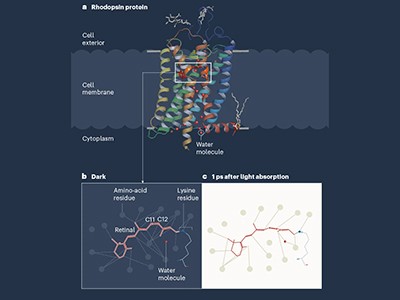THE PAPER IN BRIEF
• Ultrashort, intense X-ray pulses generated at services referred to as X-ray free-electron lasers (XFELs) have been used to probe light-induced structural modifications in proteins.
• Mild-responsive proteins sometimes soak up one optical or ultraviolet photon in pure settings, however might soak up extra from the extraordinary ‘pump’ lasers used to induce structural modifications in these research.
• Such unnatural absorption of a number of pump photons may drive proteins to behave in methods that aren’t biologically related.
• Questions have due to this fact been raised about how these research must be interpreted.
• Barends et al.1 now present that the construction of a mannequin protein modifications in numerous methods relying on whether or not single or a number of photons are absorbed.
RICHARD NEUTZE: Imperfect experiments might be informative
Structural modifications that happen in proteins throughout biochemical reactions might be measured utilizing a method referred to as time-resolved X-ray diffraction (TR-XRD). On this technique, reactions are initiated in protein crystals, and X-ray pulses are used to document X-ray diffraction information at chosen instances after initiation. TR-XRD has produced structural insights into the pathways of numerous organic processes2, together with photosynthesis, sensory signalling, ion transport and photodissociation — the light-induced breakage of bonds between proteins and their ligand molecules.
Learn the paper: Affect of pump laser fluence on ultrafast myoglobin structural dynamics
For light-sensitive proteins, a pump laser pulse is used to provoke the response of curiosity. All molecules probed in a crystal contribute to the measured X-ray diffraction sample, but sometimes solely a subpopulation is activated by the pump laser. A amount referred to as the crystallographic occupancy estimates the fraction of molecules in a crystal which might be activated. Elevating the pump-laser fluence — the power delivered per unit space by the pump laser onto a crystal — can enhance the crystallographic occupancy, however a couple of photon might be absorbed by the protein at excessive laser fluences3,4.
Barends et al. studied structural modifications that happen within the carbon monoxide complicated of the protein myoglobin (MbCO) after pump-laser-induced photodissociation of CO from the iron atom of a haem group (Fig. 1). This course of was beforehand studied utilizing TR-XRD at time resolutions of seven.5 nanoseconds5 and 150 picoseconds (1 ps is 10–12 seconds)6 utilizing comparatively giant protein crystals (dimensions within the vary of about 0.1 to 0.3 millimetres) and X-ray pulses from a synchrotron facility, which is a much less intense X-ray supply than an XFEL.

Determine 1 | Structural dynamics of a mannequin protein system. Barends et al.1 used a technique referred to as time-resolved X-ray diffraction (TR-XRD) to review crystals of the carbon monoxide complicated of the protein myoglobin (MbCO; solely a part of the complicated is proven). They used a ‘pump’ laser pulse to induce photodissociation (breakage of the bond between CO and the iron (Fe) atom of a haem group within the protein), after which used ultrashort, intense X-ray pulses to acquire X-ray buildings of the protein over time. Three structural modifications essential to photodissociation are proven (proper): flexing of the haem group; modifications within the distance between the haem and a histidine amino-acid residue within the F α-helix of the protein; and displacement of the F-helix. The authors noticed that the fluence of the pump laser (the power delivered per unit space by the pump laser onto a crystal) alters the amplitude and timing of those motions, and likewise the movement of the CO away from the haem after photodissociation — suggesting that decrease fluences are wanted to look at structural modifications that happen in pure settings.
A 2015 examine by a few of the similar researchers as Barends et al. used extraordinarily quick, intense XFEL pulses to document TR-XRD information from tens of hundreds of a lot smaller MbCO crystals (common measurement 15 micrometres × 5 µm × 3 µm). This thereby achieved a time decision of 250 femtoseconds (1 fs is 10–15 s) and revealed ultrafast conformational modifications of the protein as photodissociation happens7. However as a result of these experiments used a excessive pump-laser fluence, Barends et al. have now repeated their examine utilizing a decrease fluence that ensures single-photon excitation of MbCO.
The authors used their TR-XRD information to find out distinction Fourier maps, which present variations in electron density in MbCO earlier than and after activation. Barends et al. discovered that decrease pump-laser fluences yield decrease crystallographic occupancies in maps produced 10 ps after protein activation. For this time delay, variations between structural modifications induced by single-photon and multiphoton excitation are troublesome to see from the distinction Fourier maps, however the authors argue that some results might be decided from cautious evaluation and structural modelling. A caveat is that structural modelling incurs bigger errors when the crystallographic occupancy is low.
Clues to how water splits throughout photosynthesis
For sub-picosecond time delays, the authors’ evaluation reveals that the protein responds unexpectedly quickly to the very best pump-laser fluence, and that CO swiftly populates a brand new location close to the haem (Fig. 1). Against this, it takes longer for the protein to reply and for this CO web site to be populated after single-photon activation.
Barends and colleagues’ recording of high-quality maps from very small crystals of MbCO after single-photon excitation is spectacular. Their examine will inspire different researchers to get better high-quality distinction Fourier maps utilizing single-photon excitation. Nonetheless, this may not be potential for a lot of organic programs. Crucially, the structural perturbations of MbCO induced by single photons are in step with findings from earlier work5–7, illustrating that helpful perception does emerge from imperfect experiments. Traditionally, the sector has chosen to not let the proper be the enemy of the nice. I contend that such pragmatism ought to proceed, in order that the range of organic programs studied by TR-XRD continues to develop2.
R. J. DWAYNE MILLER: Protein ‘music’ should not be distorted
Organic processes are pushed by chemistry. Chemistry is dynamic, with all of the interconnecting atoms in molecules jiggling round, vying for proper of method to participate in response pathways. In proteins, chemical transformations happen at an energetic or binding web site. These processes contain the coupling of response forces such that some 10–100 atoms on the energetic web site direct the motions of the 1,000–10,000 (or extra) atoms of the encircling protein. An astronomical variety of potential conformational pathways (sequences of molecular buildings) can happen, however just one or a number of motions on the energetic web site — referred to as response modes — direct organic operate.
How can such a small variety of response modes preferentially direct protein features throughout the ocean of other conformational pathways? This obvious paradox is solved by contemplating spatially correlated motions — these come up when forces imprinted within the protein construction trigger atoms to maneuver collectively, reasonably than randomly and independently. By immediately observing atomic motions throughout the defining moments of a chemical response, the preliminary distillation of all potential pathways down to a couple response modes might be seen8. Such observations enable relationships between protein construction and performance to be decided, however provided that the response is initiated accurately. The entire level of such research is that we don’t know the size and timescales of protein responses to the chemical driving drive.
To assist make sense of this situation, take into account the fluid that kinds by mixing cornflour and water. If you happen to dip your finger slowly into this combination, the fluid flows round it like a liquid. However in case you quickly poke the combination, the fabric responds as an elastic stable. Equally, the spatially various boundaries to motions in proteins imply that protein responses to forces rely on each the time and the size scales of the utilized drive. On condition that protein buildings are extremely anisotropic (totally different in numerous instructions), the response may also rely on the spatial location of the induced drive.
Earliest molecular occasions of imaginative and prescient revealed
Till the work of Barends et al., femtosecond TR-XRD research had used extraordinarily excessive pump fluences to make sure that structural modifications in proteins may very well be noticed. As a result of the laser pulses are so quick, this got here at the price of inducing multiphoton protein activation that produces preliminary atomic displacements totally different to these arising from single-photon activation, and at larger energies, with the atoms being displaced farther from their equilibrium positions4. The driving forces for the noticed structural modifications had been due to this fact each spatially totally different and considerably bigger than these of the organic pathway of curiosity4.
For the mannequin MbCO system, there are three biologically essential and spatially coupled motions (Fig. 1): the haem doming coordinate (which describes the flexing of the protein’s haem group); motion of a histidine amino-acid residue positioned near the haem; and the displacement of α-helices ensuing from the switch of driving forces from the primary two motions. Barends et al. noticed that multiphoton activation resulted in a lot sooner displacement of the histidine than did single-photon activation, and led to equally sooner motions of one of many helices. Furthermore, the spatially correlated helical motions prolonged over totally different distances alongside the helix than did these induced by single-photon activation, and subsequently dissipated to totally different levels.
The impulsive nature of the drive produced by multiphoton activation on the preliminary histidine movement, and the temporal evolution of the positioning of the CO molecule within the protein pocket that comprises the haem, are proof of a unique response pathway to the one produced by single-photon activation. There are vital variations within the magnitude, temporal evolution and pathway of the structural dynamics all through the protein.
Given the significance of energetics and spatially correlated motions for understanding the structural modifications that underpin protein operate, we have to get this proper. Biologically related protein motions are like music, albeit enjoying at frequencies we are able to’t hear. We have to observe the motions that correspond to sure frequencies, and discern how these motions are damped to provide web displacements. Think about listening to music wherein violin strings are struck too strongly, inflicting the unintentional enjoying of various chords collectively. You wouldn’t hear the music as written, however one thing else totally. To grasp how nature works, we have to hearken to the molecular music as nature wrote it. Barends et al. have executed simply that.




